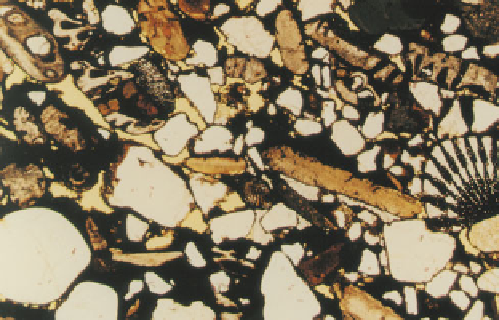Geoscience Reference
In-Depth Information
75
76
75
Onyx-marble that has been stained in accordance
with Dickson's method. The red bands consist of
nonferroan calcite while the blue bands consist of
ferroan calcite. The white (unstained) bands are
composed of dolomite; PPT, ×25.
76
Ironstone (England) consisting of shell fragments
(light brown) and quartz grains (white), cemented by
iron-bearing minerals (black); PPT, ×25.
77
78
77
Flint from the Chalk (Upper Cretaceous, England)
consisting of microcrystalline and cryptocrystalline
silica (grey). Fossil remnants representing the rock
texture prior to chertification are seen in this example;
XPT, ×35.
78
Alabaster consisting wholly of gypsum crystals;
XPT, ×35.
siderite, and berthierine. Sedimentary ironstones may be
hard and calcareous and contain quartz grains, ooliths,
pebbles, and a wide variety of macrofossils. They are
used for building locally and are characterized by their
strong yellow-brown or orange-brown colours when
weathered.
Flints (
77
) are composed of pure, dense, crypto-
crystalline silica (chert). They occur as layers of black
nodules with a white outer cortex, throughout much of
the Chalk of western Europe or in gravels weathered from
the Chalk. They are used for building in areas where there
are few other suitable stones. They may be used as rubble
wall fill or as squared and knapped flint wall facings.
Alabaster (
78
) is a decorative stone composed of
gypsum (CaSO
4
.2H
2
O) in a fine-grained, massive, and
compact form. The purest form of alabaster is white and
translucent, but traces of iron minerals produce light
brown, orange, or red streaks. The term alabaster is
sometimes incorrectly used to market decorative stones
composed of calcium carbonate such as onyx-marble.
True alabaster is composed of gypsum.





